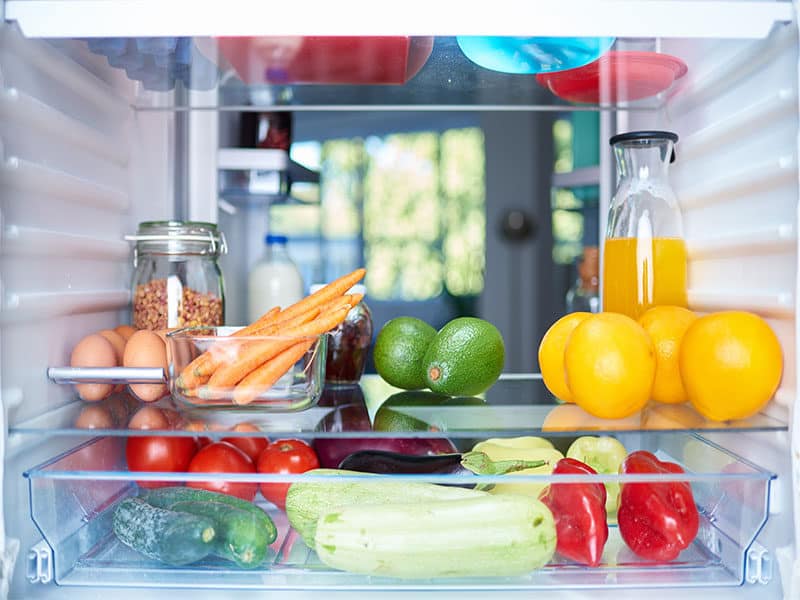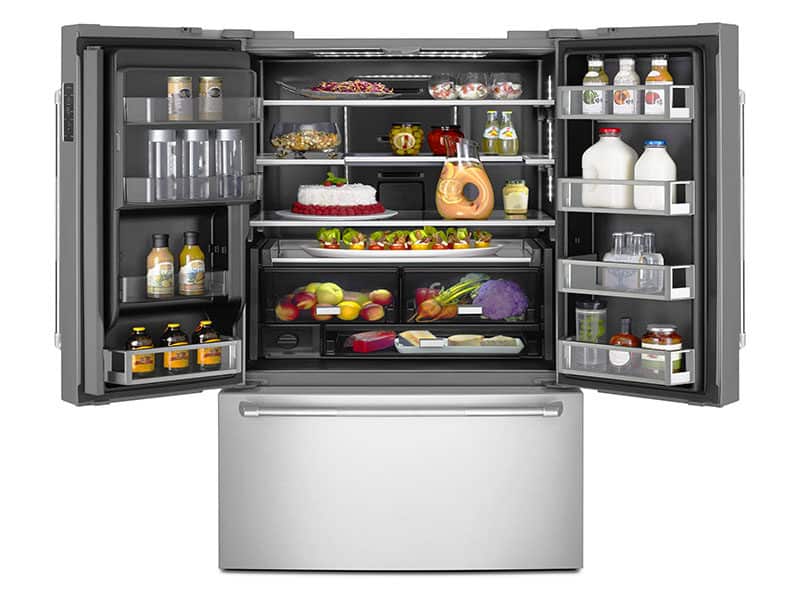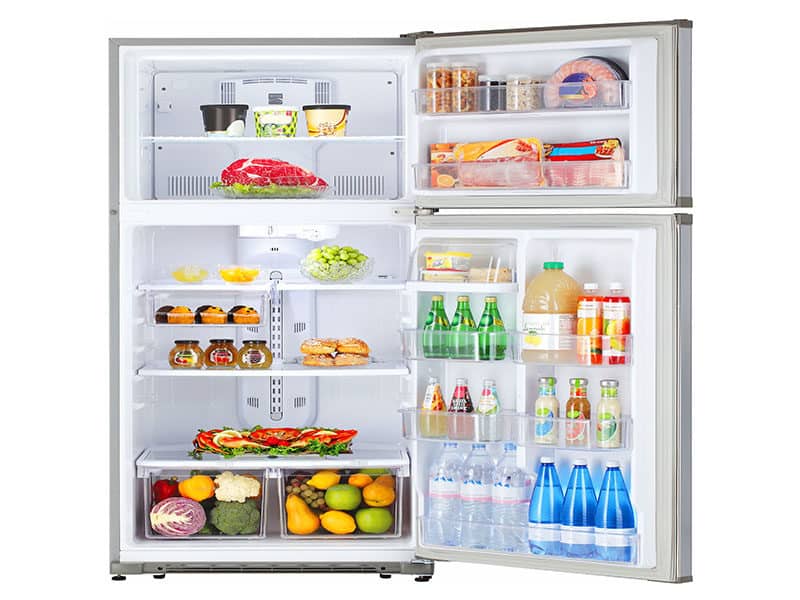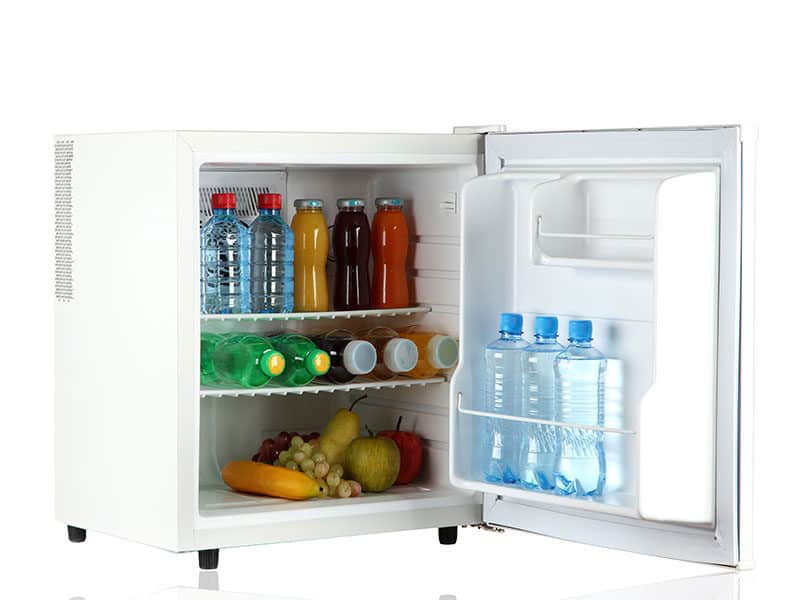If you’re moving or shopping for new appliances, you may be questioning how much does a refrigerator weighs. Still, you are looking for something more specific, aren’t you?
You need to know the weight and how many amps a refrigerator consumes, especially moving the item from A to B. Nobody wants to be caught with excessive weight lugging around. It is essential to know the scale, whether you wish to remove your fridge or exchange a new one.
As an excellent general thumb rule, refrigerators weigh about 12 pounds per cubic foot of capacity. But’s first, I start with the reasons and features that weigh up your frozen-mate.
FACTORS Weigh Up A Refrigerator

It is crucial to remember that the refrigerator is bulky as well. The fridge is clunky and difficult to manage instead of a deadlifting or a 300 pounds bench, which is sleek, streamlined, and specially designed to lift.
It was not made for lifting and movement; it was built for your food as a frost fortress, for instance, kept the high-quality frozen burger safe, maintained the perfect texture of luscious cheddar cheese, or kept apple juice bottles cool all the time!
Many factors influence the weight of a refrigerator, irrespective of its brand—all about the significant factors affecting a fridge’s weight you can found here.
Manufacture Year
The old refrigerators have heavier electrical items and more giant propulsion tanks. These fridges generally weigh approximately 250 pounds.
In contrast, refrigerators of the new generation are made of lightweight materials and have removable features. It means they weigh between 170 and 350 pounds on average.
Refrigerator Model
A lot of refrigerator models are currently on the market. Different models are usually weighed differently. Models such as side-by-side and French door types appear to be heavier than most refrigerator models.
Refrigerator Size
Refrigerators of 10 feet high weigh less than refrigerators 25 feet tall. It is also essential to select a refrigerator based on the size. In the current market, there are many great small-sized fridges with various price ranges so you have more choices to choose from.
And please remember, high refrigeration means they have many accessories compared to smaller refrigerators.
Refrigerator Features
A refrigerator with many extra items, such as water filters, is probably heavier than those with a few supplements. These additional materials also contribute to the refrigerators’ overall weight.
The Refrigerator’s AVERAGE WEIGHT By Types
Choosing the right size refrigerator can minimize grocery bills and food waste because you can buy less and use them in time before they go bad.
Down there, you can find some standard versions, such as how much they weigh in these types of refrigerators.
French Door Refrigerator

The French door items have side-by-side double doors, and a bottom freezer with 1 or 2 drawers can easily be found. With this characteristic, you’ll find it hard to tell apart between side-by-side and French door refrigerators. But if you look closer, you will find their distinctions.
However, regardless of what types of these two, they are gained around so fast by modern homeowners because of their simple design, which you will have an excellent place to store the harmony taste from your half-eaten ratatouille bought from Provence.
Below are the different French door items and their respective weights from various producers.
- 284 pounds- LG Electronics’ 26.2 Cu. ft. French Door Refrigerator
- 308 pounds- Samsung’s 24.6 Cu. ft. French Door Refrigerator
- 320 pounds- Whirlpool 24.5 Cu. ft. 4 Doors French Door Refrigerator
- 348 pounds- KitchenAid 20.0 Cu. ft. French Door Refrigerator
Top Freezer Refrigerator

These are ordinary, compact, lightweight refrigerators suitable for a small household of up to three people. Compared to the bottom freezers, the top freezer refrigerators are more energy-efficient and spacious.
So suppose you have tons of cream cheese and don’t know cream cheese shelf life, just store them in the fridge at the right temperature! Now, let’s check out brands with excellent models and weight on average:
- 118 pounds- Haier 11.6 Cu. ft Top Freezer Refrigerator
- 181 pounds- Samsung 18 Cu. ft Top Freezer Refrigerator
- 205 pounds- Maytag 20.6 Cu. ft Top Freezer Refrigerator
- 221 pounds- Kenmore 21 Cu. ft Top Freezer Refrigerator
- 223 pounds- LG 24 Cu. ft. Top Freezer Refrigerator
Bottom Freezer Refrigerator

This type of refrigerator is broad and has more space for easy covering any large objects. The bottom is generally built for more room using any unused space. Soon you will find a bottom freezer is a suitable place for your frozen lasagnas, my mate!
Great brands and their specific weights are available here:
- 167 pounds- Bosch 11 Cu. ft Bottom Freezer Refrigerator
- 236 pounds- LG 24 Cu. ft. Bottom Freezer Refrigerator
- 255 pounds- Whirlpool 22.07 Cu. ft Bottom Freezer Refrigerator
Mini Refrigerator

Depending on the size and model, most mini-fridges range from 40 to 80 pounds; some orders are lower than 150 pounds. These kinds of refrigerators are ideal for small areas with a few people using them. When you call for a fridge placing in rooms, they are also budget-friendly.
It’s time to jump to the slide mozzarella cheese as fresh snacks right after a nap in bed.
- 48 pounds- Kuppet 3.2 Cu. ft Mini Refrigerator
- 60 pounds- Insignia 3.0 Cu. ft Mini Refrigerator
- 112 pounds- KitchenAid 4.9 Cu. ft Mini Refrigerator
And, are there any frozen burgers still staying in your freezer for nearly a year? When the answer is yes, you should question yourself whether you pick the right fridge size. Last but not least, you do need to define the mass of your home fridge, too.
Capacity is a significant weight factor in today’s refrigerator models. Right in the next part, I will rank up why this tool’s weight is necessary.
Why The Refrigerator’s WEIGHT Is Important?
Refrigerators are less heavy than similar units from 30 years ago with technological advances. Many latest refrigerators, including door-to-door ones, have a much bigger capacity and more adding-weigh advances.
To maintain the refrigerator for years to come, the configuration and capacity or the style are significant. The consideration of the refrigerator’s weight is vital for two main reasons. The first is the location where the fridge is put, and the second is about moving the fridge.
SAFE SUPPORT For The Floor

When you see an attractive French Door refrigerator on the showroom floor, you will not consider the weight anymore. You can only consider whether the fridge fits into your kitchen room or not.
Floors, however, are built to be so powerful. Wooden floors are the most common residential building. The floor has a dead load and a live load in residential building codes. Let’s see how much weight the floor can support your machine.
Dead Load Measuring
Dead load applies to the floor materials and any permanent floor covering, such as carpet or vinyl. The dead load is usually between 8 and 9 lbs. per square foot on a wood floor (psf).
This number varies depending on certain factors, such as non-wood flooring materials. As in a multi-story structure, materials added to the base underside can also be an essential element.
Live Load Measuring
The live load of your floor refers to furnishings, non-fixed equipment, human occupancy, and everything else that is not fixed permanently on the floor. The uniform code sets out a load for wood flooring of 40 lbs. per square foot (psf).
The code calculation is different from other flooring styles, for example, concrete, with a much larger live load. Live loads are also known as equally distributed surface weight.
Area Weight Calculating
You can measure how much weight is safely added to an area using the International Residential Code as a reference.
You can add food a hundred pounds or more in some larger refrigerators. For instance, you can have the live load code weights around 340 (40 pounds per 8.5 square feet) added into your LG
Electronics’ 26.2 Cu. ft. French Door Refrigerator.
Refrigerators are popular with the newest French Doors. In general, the bigger the fridge, the less likely the coding of wooden floors would be. It especially applies to food stocks.
Floor Condition In The Refrigerator’s Zone
Another factor in the scale matter is the floor condition. Live load applies to a newly built floor with a uniform code. If the floor isn’t new, other factors should be considered before moving a refrigerator to the place.
- Sagging Space: Over time, there is fatigue in the wooden floor. In the area where you want to replace the fridge, the floor may display signs of sagging.
- Water Damage: There could be water damage, maybe from a fridge that has previously leaked. The crack of water may also be indicated by warped vinyl or broken tiles in the designated area.
- Deteriorating Vapor Barrier: Where the floor is over a crawling area, the vapor barrier in the floor that lacks or deteriorates can damage moisture. The base is degraded, and probably the uniform live code can no longer be supported safely.
- Termite Damage: Like water damage, the termites can thrive on the floor already weakened by moisture. Other insects feast on damp wood as well.
Here are several factors that can prevent the wooden floor from supporting the live load. A check of wood fatigue or moisture in the entire kitchen floor may avoid a more expensive building project later.
MOVING The Refrigerator

Not only are refrigerators enormous, but they also weigh A LOT. It could be preferable to leave the dangerous refrigerator moving job for the pros depending on your particular house movements.
As the chance of damage to property or personal injury is too high and ultimately impossible to justify.
However, this refrigerator moving guide is just what you need if hiring movers isn’t a viable choice for you. Read more here to learn how to drive a refrigerator.
What You Will Need?
It is not a joke to move a fridge yourself, so here’s what you need to do safely. Please note that you do need to have at least two clever people to help.
- Plywood panels or furniture sliders
- Packing and measure tap
- Rope
- Furniture blankets
- Work gloves (for better gripping)
Do not start a refrigerator moving job until you are prepared and assured you can manage it with the required equipment and supplies. It’s a bad idea to rush the preparation or, worse, the fridge relocation.
Tips For Moving
Refrigerators, as you already know, are clunky, heavy, and challenging to drive. Moving them is a pain in the neck; there’s no way around it. But you can help the task less painful by doing such basic things.
#1 Remove All The Inside Stuff
Not only would it lighten the load, but when your fridge is moving, you don’t want food and lose shelves to bounce. Put perishable products into a cooler with sufficient ice to keep them cold for as long as they’re refrigerator-less.
#2 Disconnect & Defrost The Refrigerator
If your ice maker is functional, extract all the cubes before they melt. Check the user manual for the precise instructions for defrosting and disconnecting your fridge.
#3 Secure Tubes, Wires, And Doors
Use a movable strip to ensure that the doors are shut and prevent the refrigeration tubes and power cables from dragging on the ground.
#4 Make A Detail Plan
Measure your refrigerator’s height, width, and depth, and your hallways and doorways. Remember, in your home and fridge; you can remove doors if needed. Have a plan on exactly how you can travel and remove furniture that will obstruct your way.
#5 Rent Or Buy The Appliance Dolly
If you have to clean behind your fridge, you can slide it all by yourself because most wheels go backward and forward.
#6 Move With The Dolly
Slide the refrigerator out of the cutout and place the dolly on one side. Do not place the dolly on the machine front or back.
The back of the refrigerator has tons of compressors and cooling tubes, destroying the dolly but not having a snug position. The front of the tool is its lightest side, and the handles, doors, and dispensers of water/ice are in the way.
If the dolly is placed, wrap the strap around the refrigerator and keep it secure as directed from the instruction. Tilt-back the dolly, but not far enough. You want to have much of the weight holding by the dolly.
Walk back when you move the refrigerator because you can’t see the front. Take some time on this video, and you can see the proper technique covers a fine job.
Watch this video to know more:
#7 Ask For A Help
Call a mate on the other side of the dolly to spot you. Your assistant will stop you from banging into the walls and destroying your home or refrigerator.
FAQs
Possibly your fridge’s heavy because of its high volume. It has many conveniences and features that can add to the machine’s weight—heading up to this section to get the standard instruction and notes about the scale and the size of your fridges.
Skinny Up Your Refrigerator

After fulfilling the general information above, you can quickly move or pick the correct refrigerator based on how much the item weight, the size matters, and the components inside.
It’s better to select a substantial, average-in-weight refrigerator for your household or business premises. The refrigerators may, in many cases, be big, heavy but have little room that is meaningless.
Due to their compact size, the mini-freezers are the lightest in major fridge types. The bottom freezer fridge has been calculated to be the heaviest. It’s now your turn to consider the criteria and measure the unit’s weight.
Comment right below your expected weight as well as the goal machine’s type. Anything further you would like to add? Stay tuned and share with your social team now. I am excited to hear about new methods to evaluate the scales of the refrigerator, too.







